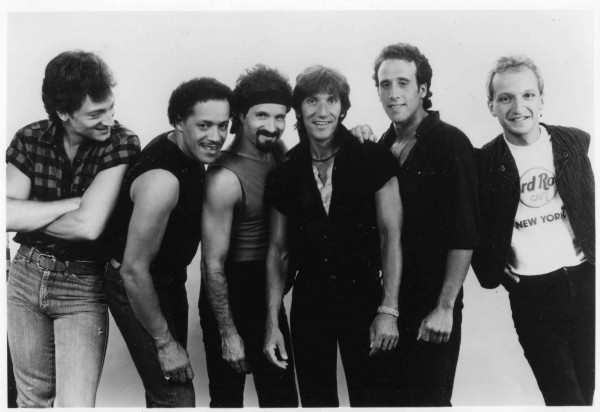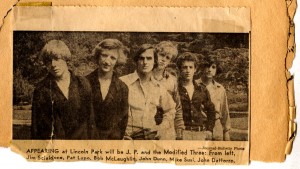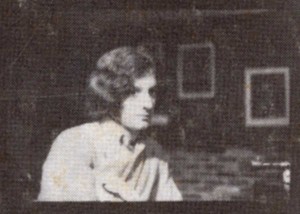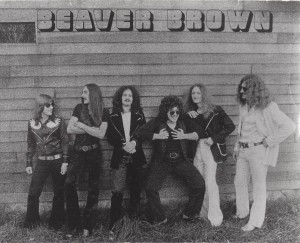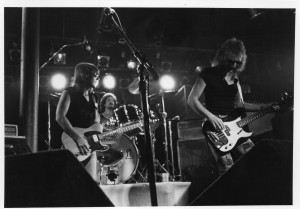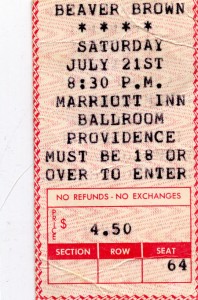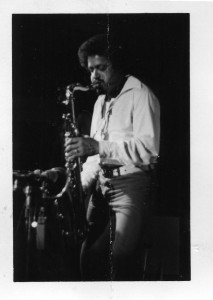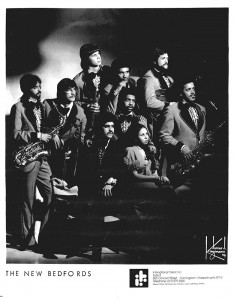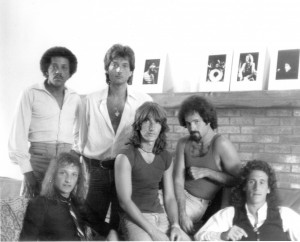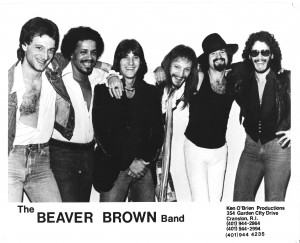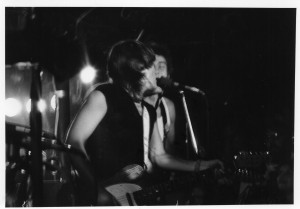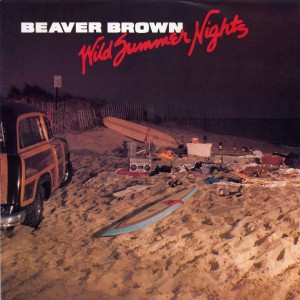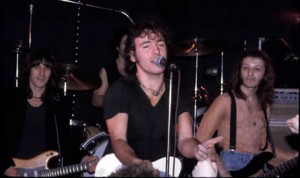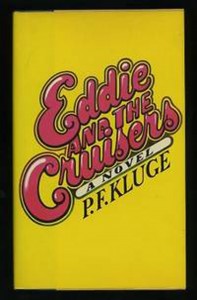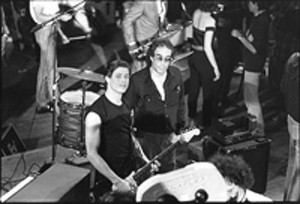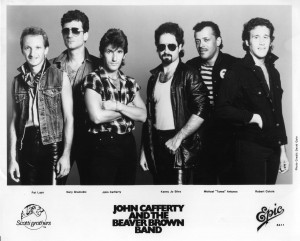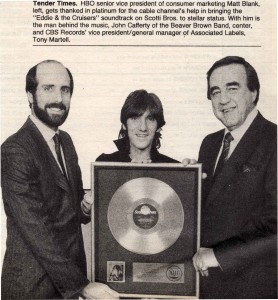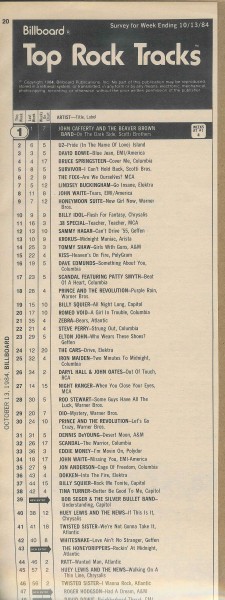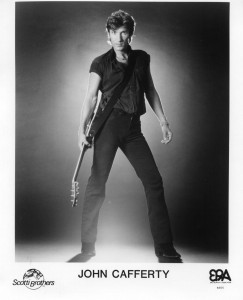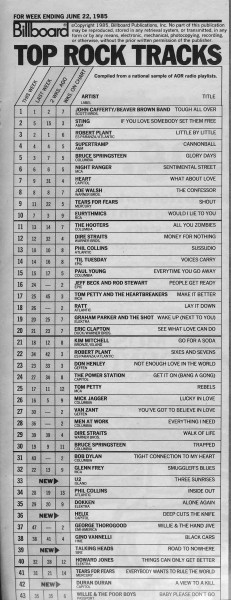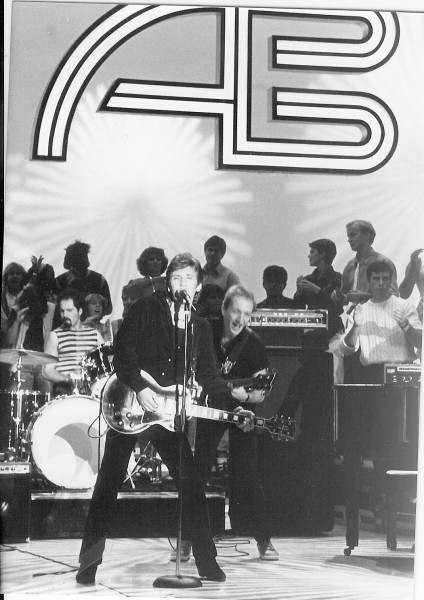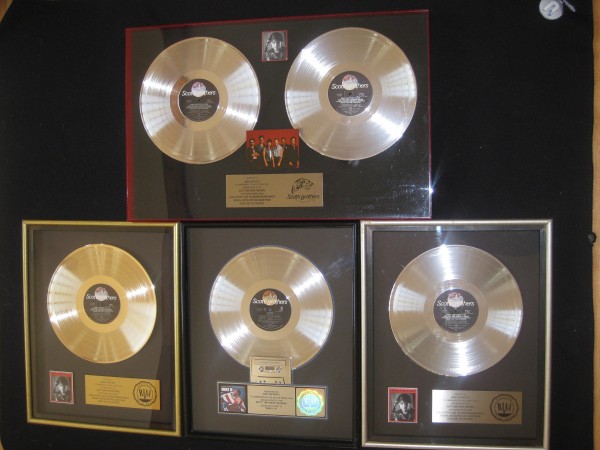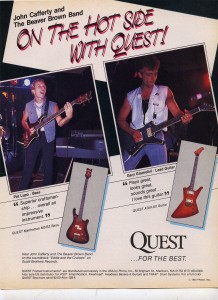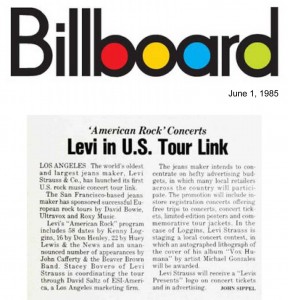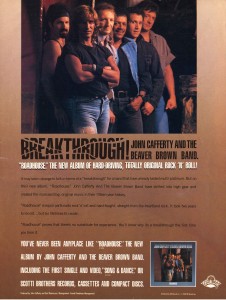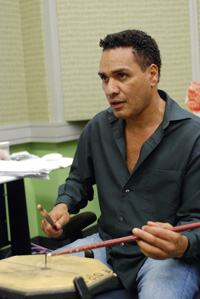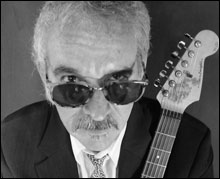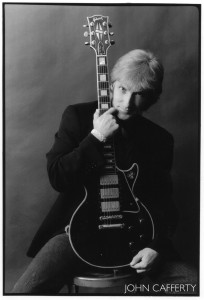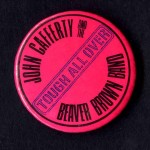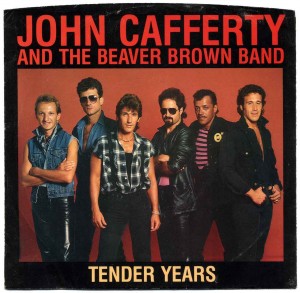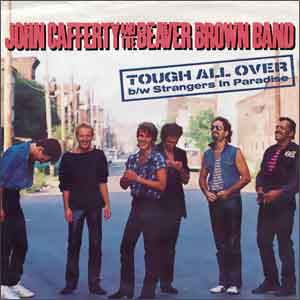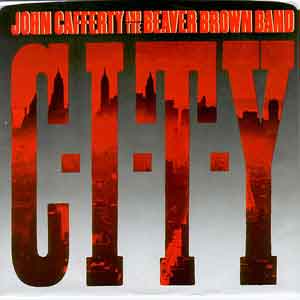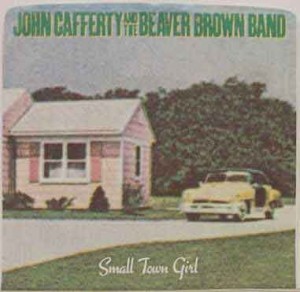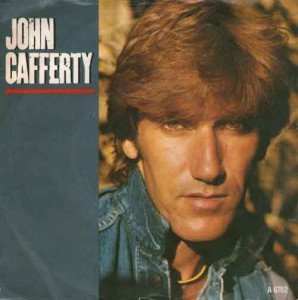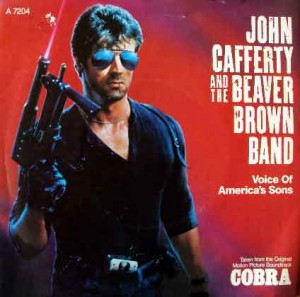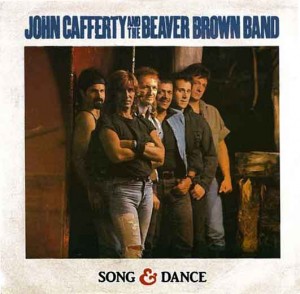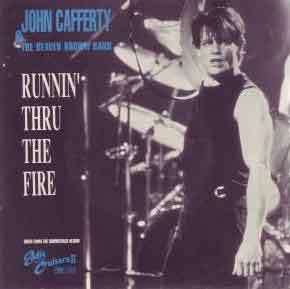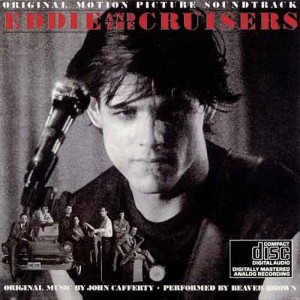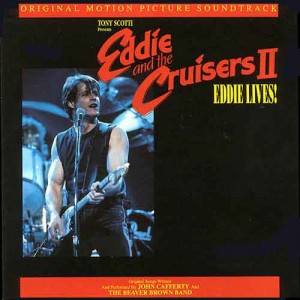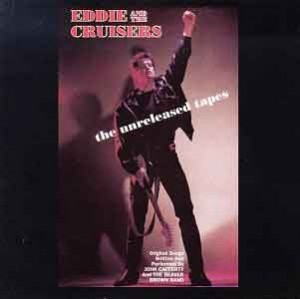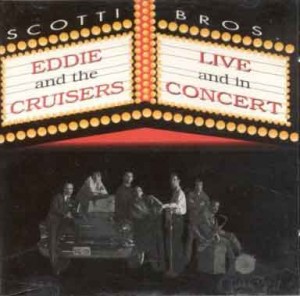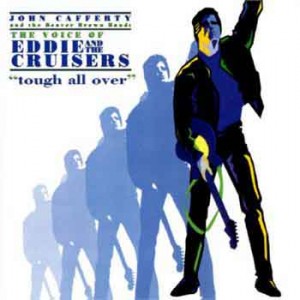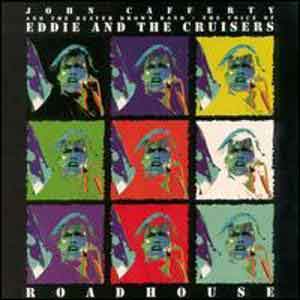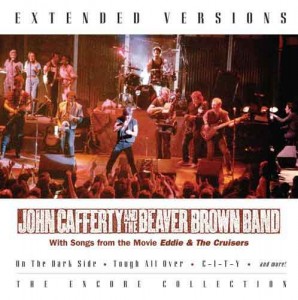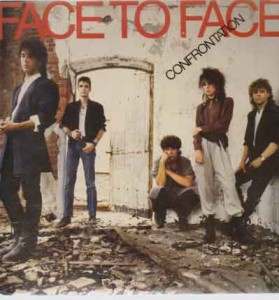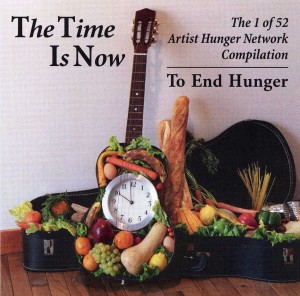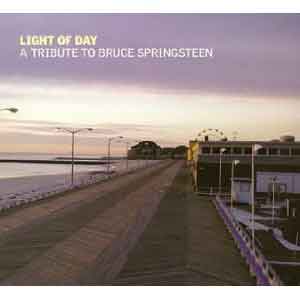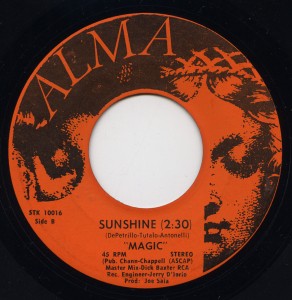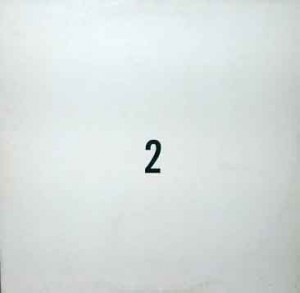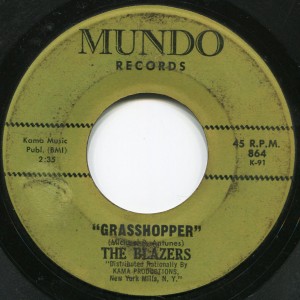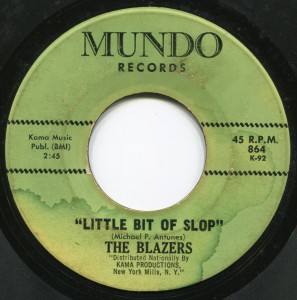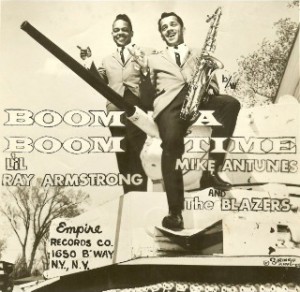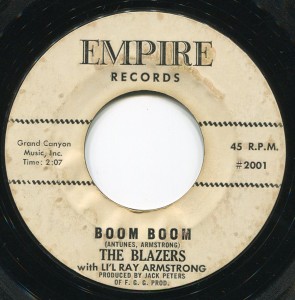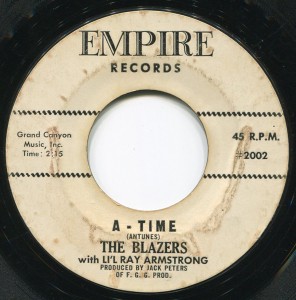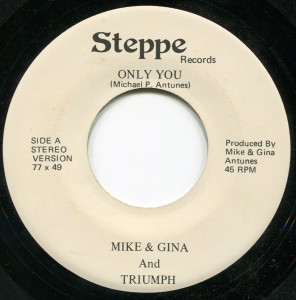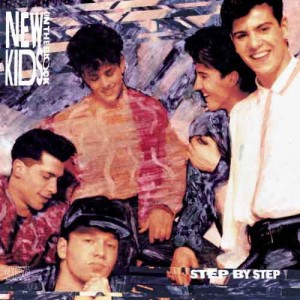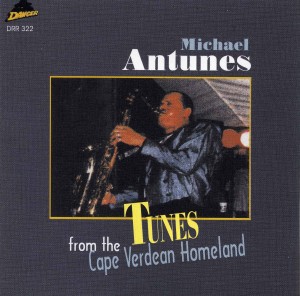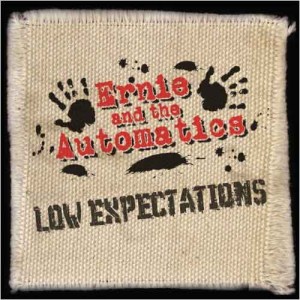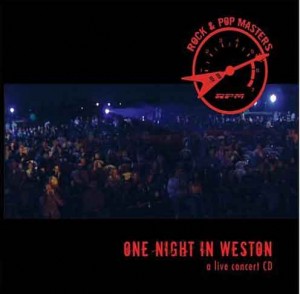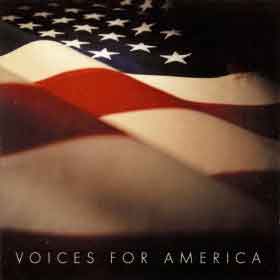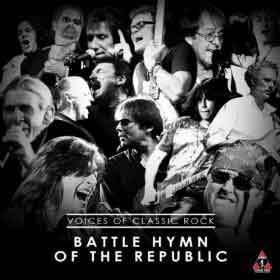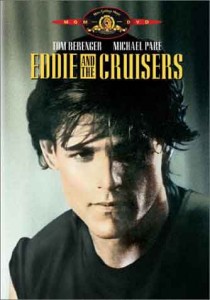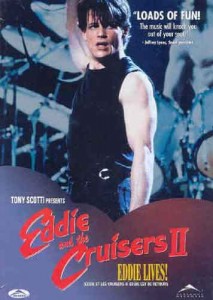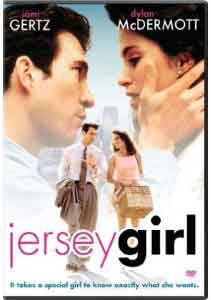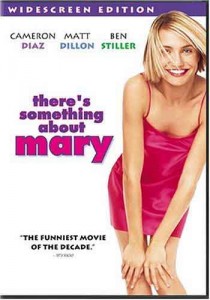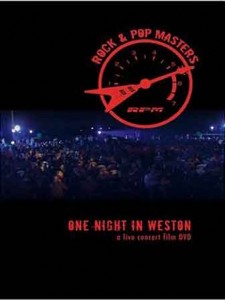John Cafferty & The Beaver Brown Band
2012 INDUCTEE
Rock ‘n’ Roll
JOHN CAFFERTY & THE BEAVER BROWN BAND
An Introduction
After a decade-long run on the Northeast music scene during which they became recognized as one of the best and most popular unsigned acts in the country, Beaver Brown finally broke through nationally with leader John Cafferty’s score to the motion picture, “Eddie & The Cruisers.” The soundtrack was awarded a double platinum certification by the RIAA and led to their own recording contract with Columbia Records. Their second album, “Tough All Over,” was a best seller and gained them an international audience. After forty years, John Cafferty & The Beaver Brown Band is an on-going and in-demand attraction and is unquestionably one of the greatest and most successful acts in Rhode Island music history. Their full biography and complete discography follow below.
Early Days (1965-1971)
Our story begins in mid-1960s Rhode Island when some junior high students formed a “garage” band they christened The Nightcrawlers. John Cafferty, a singer and guitarist from North Providence, started the group with his cousin Steve Smith, a singer from Smithfield, and another friend, guitarist Hank Clark. The band did not get much past the edge of the driveway, but by freshman year of high school at LaSalle Academy in Providence, and after Steve’s departure, John and Hank had evolved into a new unit called The East-West Blues Band named after The Butterfield Blues Band’s second album. (Within a few years, Steve Smith had formed Naked Truth, now known as Steve Smith & The Nakeds, one of the longest-running bands in Rhode Island history. But that’s another story…)
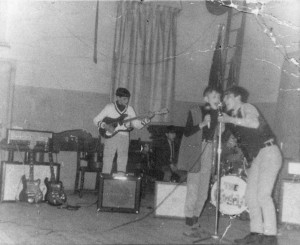
The Nightcrawlers at a “Battle of The Bands” in 1964 (left to right): Hank Clark on guitar, Steve Smith with maracas and John Cafferty on guitar at the mic; the eighth-graders won the evening against three college-age bands! (Photo courtesy the Naked Truth/Steve Smith & The Nakeds Archive/Photo Credit: Wendy Cafferty)
John credits Hank Clark with introducing him not only to the original blues recordings on which much of their listening – Rolling Stones, Animals, Yardbirds – was based, but also to the concept of musical improvisation: making up their own solos instead of learning the solos played by the recording artists. Early in the band’s run, Clark was informed by his parents that his family would be moving to another state, but he assisted the band by bringing in a friend as his own replacement, guitarist Paul Bugielski. With a rhythm section consisting of Billy Lupo on drums and Junior Box on bass, The East-West Blues Band began performing at the usual venues available to teenaged musicians at the time (school dances, CYO mixers and youth clubs).
Although the blues scene was rapidly developing in the area, the established bands such as Bob Angell’s Blues Outlet and Ken Lyon’s original Tombstone Blues Band (with Duke Robillard) were playing in nightclubs and on college campuses. Along with The Bottomlands Blues Band who were based out of Classical High School (and included pianist Joe Bargar, guitarist Fred Bates and a pre-tenor sax Scott Hamilton on harmonica), The East-West Blues Band helped introduce the blues to the younger fans in the area who were used to the usual teen fare of Top 40 and “garage band” favorites. It was during his time at LaSalle that John first met Kenny Silva of the Fox Point neighborhood of Providence and drummer with the popular teen-scene band, The Hearts Of Stone.
By the time Cafferty had enrolled at Rhode Island College, he was eager to broaden his musical outlook by adding some of his favorite Rock ‘n’ Roll and R&B material to his blues repertoire. He was looking to do something a bit more universally appealing, more commercial, but without bowing to the pressures of becoming a Top 40 cover artist. He wanted to maintain his artistic integrity, but also wished to see people dancing and having fun!
During his freshman year, he acquired a Work-Study job at the college’s coffeehouse located in the basement of the school’s Donovan Dining Center. There, he became aware the blossoming singer-songwriter scene in Providence and had the opportunity to take in performances by such area notables as Jay Bolotin and Ken Lyon and began performing as a solo, accompanying himself on acoustic guitar. He also re-connected with his high school friend, Kenny Silva.
Kenny had moved on from The Hearts Of Stone to The Luvin’ Kynd, a group which had experienced quite a bit of success on the teen scene. Thanks to the then-recently enacted laws which dropped the age of majority from 21 to 18 during the Vietnam protest-era (you could not only vote, but you could drink!), The Luvin’ Kynd had made the successful transition into becoming a nightclub act. But, they were looking to move things to the next level: become a little less commercial and a bit hipper. (As the reader will see, the notion of achieving mass appeal while maintaining high levels of musicianship and artistic integrity will become a running theme throughout the development of Beaver Brown.) John accepted an offer to join The Luvin’ Kynd and replaced departing lead vocalist David Micheletti. He joined Kenny in a lineup which also featured David DiCenzo on bass, Al Paglio on lead guitar and John Rainone on keyboards.
The band continued on through John’s and Kenny’s college years, moving away from its Top 40 roots, and were recognized as one of the best young bands on the club scene. But by 1972, the two friends had committed to pursuing careers as professional musicians and decided to stick together: they left The Luvin’ Kynd. They began searching for the right people to help them on their quest through a series of jam sessions and soon came up with the musicians who would become the basis of Beaver Brown: they brought back John’s old pal Paul Bugielski from The East-West Blues Band, and then they singled out Bobby Cotoia of North Providence on keyboards and Pat Lupo from Mount Pleasant to play bass.
Cotoia had begun his career, as had so many other musicians of Italian-American descent, as an accordionist. As a teen, he caught the Rock ‘n’ Roll bug and began focusing his attention on the piano in his parents’ living room. (Legend has it that Bobby rolled that piano down the street to attend his first garage band rehearsal!) Due to the condition of pianos (or in many cases, simply the lack of a piano) in the venues available to young bands, Bobby switched to organ – at first, a portable combo model and by the early ’70s, to the Cadillac of the instrument: the Hammond B-3 with a Leslie rotating speaker cabinet. The chops he’d acquired during his early Classical training coupled with his love of R&B organ styles had made him one of the most in-demand players on the scene. By 1971, Bobby was working as an arranger and session player at the Rhode Island branch of Boston’s AAA Recording Studios on Atwood Avenue in Johnston. The studio was run by a group of local musicians who used their access to the facilities to put together an original band called Magic which had a lot of promise and created quite a buzz on the scene. Modeled after the success of Three Dog Night, the group was fronted by four lead singers and featured Joey Tutalo, formerly vocalist of popular teen scene band The Accents, and Bobby on keyboards. They cut one single with two original songs which was released on AAA’s in-house label, Alma Records, but the record failed to catch on and the group ground to a halt when AAA closed the Johnston location.
Pat Lupo (the younger brother of East-West Blues Band drummer Billy Lupo) came into the camp as something of a local star in his own right. During the run of The Lovin’ Kind and right down the street from Rhode Island College in the Mount Pleasant area of Providence, another band was going through the same evolutionary process. J. P. & The Modified Three were the acknowledged kings of the teen scene having achieved their preeminence with their best-known or “classic” lineup consisting of Pat on rhythm guitar, John Dunn on bass, Mike Susi on drums, Bobby McLaughlin on lead vocals, and lead guitar virtuoso Jimmy Scialdone. When Dunn left the band, Pat made the switch from guitar to bass and quickly became known as one of the best players in the area. The group made a valiant effort to move with the times through several personnel changes and almost got there with a final lineup of Scialdone, Lupo, keyboardist Lucien Spino and local drum legend, Billy Carson, but there was not enough work or interest to sustain them in those changing times.
Just before joining forces with John, Kenny and Paul, both Pat and Bobby were both involved in a start-up unit called Stray Cat which was on everyone’s radar at the time. The group featured Steve Antonelli and Tom Dunn on guitars, Rusty Russo on drums, and Tom Dickie on lead vocals. Despite the stellar lineup, the band never made it out of the cellar and by the time they got the call from Cafferty, Pat and Bobby were ready to move on.
Garage Days (1972-1973)
John Cafferty and his new band began an intense series of rehearsals and made a pact to remain behind closed doors until they’d become as tight as a drum and had fully developed a style they could call their own. Early on in the process, Paul, who was studying Nuclear Engineering at the University of Rhode Island, brought in a friend of his from URI, a young Marine Biology student and guitar virtuoso from Massachusetts.
Gary “Guitar” Gramolini hailed from Arlington and spent most of the free time during his youth immersed in the instrument. He had studied guitar for 11 years and had achieved local notoriety in the suburban areas west of Boston with his high school band, The Flying Dutchmen. During his time at URI, he was a mover and shaker on the underground scene performing with an early “jam band” called Nebula with whom he cemented his reputation as a guitar master during their lengthy free-form jams in the style being pioneered at the time by The Grateful Dead and The Allman Brothers Band. (Ironically, his nickname was not the result of his reputation as a musician: when he arrived at URI, there were four “Garys” in his dorm suite and each was assigned a handle for easier indentification – Gary “Football,” etc. – and he became forever known as Gary “Guitar!”) One of the final pieces of the puzzle which would become Beaver Brown was in place.

“The Joint”, where the band rehearsed for the better part of a year before their first gig, Mount Pleasant neighborhood, Providence
They made one final addition in pianist Steve Dawson and conducted a single rehearsal at Steve’s home in Warwick as a seven piece group. The sound didn’t quite click that day and Steve bowed out. The rest of the band rented a small, vacant commercial building on Lawn Street in Mount Pleasant (which Bobby nicknamed “the joint”) and began woodshedding for the better part of a year. The band intensified their rehearsal schedule and soon Paul dropped out to concentrate on his studies and to pursue his musical interests in the new, modern “funk” styles then just gaining an audience through the work of Tower Of Power and others. On Lawn Street, the band were not only able to grow tighter musically, but as friends and co-conspirators, sharing their record collections, their personal philosophies, their hopes, their dreams.
The Birth Of Blue Collar Rock
Unaware of it at the time, the band was on the forefront of a new movement sweeping through local music scenes all across the country now known as “blue collar” or “heartland” rock. The idea behind this movement was to get back to the roots of Rock ‘n’ Roll – not to play “oldies”, but to use that primal energy as a jumping-off point for a new, original style which would celebrate the working class origins of the music. The huge technological and virtuosic strides which had moved Rock ‘n’ Roll forward during the psychedelic and “underground” eras had given way to – indeed, provided the platform for – the excesses of heavy metal and progressive or “art” rock. The music in many ways had ceased to be a communal experience. For many young musicians, it was time to return the music to the people. Early purveyors of this musical philosophy who provided the template for the artists who would become prime movers of the style were The J. Geils Band from Boston, Massachusetts and Irish R&B singer Van Morrison, formerly of British Invasion group Them.
Geils was born of the same thinking going on in basements and garages within a wide array of geographical locations in the United States. They began when one of Boston’s top party bands, The Hallucinations, merged with The J. Geils Blues Band. Singer Peter Wolf and drummer Stephen Jo Bladd of The Hallucinations were looking to get back to their blues roots and do something “hipper” while the Geils band (guitarist Jay Geils, harmonica wizard Magic Dick and bassist Danny Klein) were looking to move beyond the strictures of traditional blues forms and do something more commercially appealing. They dropped the “Blues” from their name, became simply The J. Geils Band, quickly scored a deal with Atlantic Records and were on their way to the top. Morrison had found early fame with Them (he wrote and recorded the original version of “Gloria”) and underground credibility during his “folk-rock” period (his first solo album “Blowin’ Your Mind!” which included the across-the-board smash hit “Brown Eyed Girl” followed by the critically acclaimed “Astral Weeks” album). But he, too, was looking to return his music to the mainstream and by 1972, had already produced two hit albums based on his love of the ’50s R&B styles of Ray Charles and Chuck Willis (“Moondance” in 1970 and its 1971 follow-up, “His Band & The Street Choir” which contained the hits “Domino” and “Blue Money”).
These artists were seminal influences in the development of Beaver Brown and they had a similar affect on young musicians all over the country. Down in Gainesville, Florida, Tom Petty and his cohorts Mike Campbell and Benmont Tench were shaping the style of The Heartbreakers with their original incarnation, Mudcrutch. Up in Detroit, Bob Seger had abandoned the hard rock style of his band, the System, and was putting together the musicians who would become the Silver Bullet Band. Out in Pittsburgh, Joe Grushecky was forging the frame of what would become The Iron City Houserockers. In the literal “heartland” of Indiana, John Mellencamp had abandoned the “glitter rock” pretensions of his Johnny Cougar period and with his third album (“A Biography” released only in Europe) was beginning to develop the style which would make him famous as John Cougar. And all along the New Jersey shore, a large gang of friends including Bruce Springsteen, “Southside” Johnny Lyon, “Miami” Steve Van Zandt, Billy Chinnock, Norman Seldin, Clarence Clemons and John Eddie were trying out the various combinations which would culminate in The E Street Band and The Asbury Jukes.
Ladies And Gentlemen…Beaver Brown! (1973-1974)
Back in the north end of Providence, the nameless, endlessly rehearsing band that was to become Beaver Brown soldiered on. They shared a wealth of common influences (the British Invasion, The Beach Boys, the blues, Dylan’s first forays into electric music), but each brought something unique to the table: Bobby’s seemingly dichotomous style merging classical delicateness with hard funk; Pat’s Top 40 economy coupled with an interest in jazz; Kenny’s rock solid drumming based on the styles of Ringo Starr, Charlie Watts and Motown’s Benny Benjamin; Gary’s improvisational skills; and John’s love of early Rock ‘n’ Roll and soul, from Elvis Presley and Jerry Lee Lewis to Spector’s “wall of Sound”, from the street noise of Dion’s white doo-wop to the “blue-eyed” soul of The Young Rascals. Over the course of a year, all of these ingredients were added to the pot and the resulting musical stew became their new and unique sound. From the start, there was a lot of buzz building up around this project. All five of the musicians were major players on the scene and it was generally known that they were holed-up working on something, but they’d virtually disappeared from public view. By 1973, they’d finally decided it was time to debut their new sound, but they realized they lacked a name! Throwing ideas around and not coming up with anything useable, someone in the band – Cafferty thinks it was Cotoia – spotted a can of house paint on a shelf in their Lawn Street hideout. The color of the paint was “Beaver Brown” and it was agreed that it had a certain ring to it and for lack of a better idea, they adopted it as their name.
From the get-go, Beaver Brown displayed a musical tightness and a level of professionalism rarely seen on the Rhode Island music landscape beyond the scope of the top commercial acts in the area such as The Northeast Expressway and The Blue Jays. But this was Rock ‘n’ Roll, real and raw, being presented with the same production values. Great pains were taken to acquire a top-notch P.A. system, stage lights and the best instruments and amplifiers and little time was wasted on stage between songs. Beaver Brown came out of the box fully formed and ready to take on the world. The original five-piece lineup of the band made their debut performance on May 11, 1973 at The Ram’s Den, the on-campus rathskeller at the University of Rhode Island in Kingston. The repertoire consisted of their favorite songs from the ’50s and ’60s (Rock ‘n Roll classics, R&B, Soul, Stones, Dead), but reimagined and reinvented in the band’s hard rockin’, pedal-to-the-metal style. John’s powerful vocals and commanding stage presence were the central focus, but dancing was the order of the day. (The first song ever performed by Beaver Brown, according to Kenny Silva, was Marvin Gaye’s “Don’t Do It” in an original arrangement which borrowed from the then-recent covers by The Band and The Who.) Thanks to Gary’s and Bobby’s skills as improvisors, numbers could be extended until the dancers began to fall away and the crowd at a Beaver Brown show never left the building less than exhausted. Beaver Brown was immediately successful and quickly became the band to watch, the group most likely to succeed. For the band itself, there were still a couple more touches needed to become a finished product.
The first was the addition of a saxophonist. The band wanted to add another color to their palette in order to continue their musical journey by exploring certain styles (honkin’ R&B, the Motown soul of Junior Walker) and to cover certain material with which they felt a kinship (Van Morrison in particular) in order to stay up-to-date and keep the people coming back. They enlisted Fred Macari and it became immediately apparent that this was the missing piece of the puzzle and that the saxophone would play a major role in the further development of the Beaver Brown sound. Fred had studied music in the Cranston school system with the great educator and trombonist George Masso. After beginning with the classical clarinet, he had become adept at several instruments and had been a founding member of The Luvin’ Kynd, John’s and Kenny’s musical Alma Mater.
The new approach helped them rapidly expand their fanbase and by the end of 1973, they’d acquired the services of one of the most powerful booking agents in southern New England, Kenny O’Brien. O’Brien was fully taken with Beaver Brown’s potential and put all of his resources behind them. He filled their calendar with lucrative club dates and college appearances and expanded their geographic territory into Massachusetts and Connecticut. By the end of the year, Beaver Brown had become a full-time job for the young musicians.
The scene onto which Beaver Brown emerged revolved around an extensive nightclub circuit and evolved into a platform for original music. When the voting rights laws, along with the legal drinking age, were lowered to 18 to match the age for selective service eligibility during the Vietnam War protest era, the club scene exploded: bands were able to perform 3, 4, 5 even 7 nights per week, especially during the summer months. The number of colleges in southern New England was a very big plus for the club scene. When the “age of admission” was lowered to 18, the clubs were packed with college kids every night – and college kids not only loved to rock, but were especially knowledgeable about music due to the proliferation of publications treating rock ‘n’ roll seriously and the rise of FM radio. It was a unique set of circumstances for young musicians, never before experienced in the history of American popular music.
As John Cafferty recently put it, “We played 4-5 sets a night, 4-5 nights a week…for years! The more you played, the better you got…and the better you got, the more you played. Wanting to work hard is one thing; having the opportunity to work hard is another. Of all the variables that may have influenced our story in a positive way, the opportunity to play thousands of sets in front of an audience is right up there at the top of the list.”
The second, and last, missing ingredient was original material and Beaver Brown looked to Cafferty to provide it. As local bands honed their craft during this era, many began introducing their own songs into their acts and the Beaver Brown band was among the first on the Rhode Island scene to do so. As the band’s conceptual center, John knew their music would have to come from the heart and began to compose material based not only on the musical influences which made up the band’s identity, but also based on their lives, social standing and life experiences in southern New England. They began working originals into their shows and the audience response was immediately favorable.
After about a year, Fred decided to leave Beaver Brown in order to explore different styles and joined one of O’Brien’s other main attractions, Morning. Beaver Brown quickly snatched up another area musician, Paul Jackson, to replace him. Paul’s sound was broader than Fred’s, more Rock ‘n’ Roll than R&B. He was quickly integrated into the fold and his sound served to give the band a harder edge.
Wild Summer Nights (1975-1979)
For the next couple of years, from roughly 1975 through 1976, Beaver Brown continued their rise and became one of the most successful bands in New England. Cafferty credits the band’s friend Mike Nardella with helping the band to choose great material to fill out the long, four set marathons which were the order of the day for nightclub work at that time. Mike was an avid record collector who parlayed his knowledge into a successful club DJ operation, Nard’s Rock ‘n’ Roll Revue. He was charged with keeping dance floors full and customers happy during the periods when bands took their breaks. (40 on – 20 off!) John and Mike spent long hours discussing on-stage pacing and presentation and that added another touch of chrome to Beaver Brown’s already polished act.
During the summers, they became the band of choice on the vibrant beach scene in southern Rhode Island which revolved around Schiller’s, The Bon Vue and The Beachcomber in Narragansett, and The Blue Sands and The Wreck in Misquamicut. (The band also began renting a waterfront house – a small mansion or “summer residence” – near the beach they used as their headquarters which is why so many biographies refer to them as a Narragansett band. As Cafferty says, “$500.00 a month to rent, $1000.00 a month to heat!”) They were adding more and more original material and were even being presented in concert on occasion. Some of the early songs, such as “Down Along The Cove” and “Sandy Lane”, had become fan favorites. They presented panoramic views of life in Rhode Island much in the same way as the material being proffered by their contemporaries elsewhere in the country provided glimpses into their lives such as Bob Seger’s “Turn The Page” and Bruce Springsteen’s “Rosalita”. The record companies were beginning to take notice of the band and it seemed as if it was just a matter of time before Beaver Brown would break out on a national level.
It’s around this time that the first fly appeared in the ointment. Despite the sell-out crowds without a record release and despite their rapidly expanding territory, certain critics began unfairly comparing the band to Bruce Springsteen & The E Street Band and writing them off as sound-a-likes. It soon became apparent that the A&R reps at the companies were buying into that argument as no record deal materialized although they were given serious consideration by most of the majors. But if anything, the comparisons should have worked in their favor. After the breakthroughs of Seger and Springsteen, it should have been apparent to the record companies that a new musical movement was afoot and that the general audience was ready to take all it could get. If one examines the chronology, it becomes obvious that all of these artists were, at first, operating independently without knowledge of the others. Their similar musical styles and lyrical subject matter were coincidental and simultaneous. They’d all arrived at approximately the same place at the same time because they shared the same musical roots and because they shared a vision about the true meaning and power of Rock ‘n’ Roll. It is also noteworthy that by this time, the band had become friendly with both the Seger camp and the New Jersey contingent who offered them much support and encouragement.
Also around this time, 1976, Gary Guitar decided to leave the band due to musical differences. He was eager to lead his own band and to explore the ’60s soul music styles he’d loved as a kid. He formed East Coast Muscle, a seven piece horn band, and they quickly became a staple on the New England club scene.
Beaver Brown carried on as a five-piece with Cafferty stepping up on the lead guitar. They did not appear to lose momentum in any way – the crowds were as big as ever. If anything, they seemed even more determined to continue on their chosen path and it seemed as if nothing could get in their way. Cafferty was perfecting his songwriting craft and turning out shorter, more concise songs. The musical styles and subject matter were still drawn from the same sources, but now the band would be presenting “short stories” instead of “novels” and the songs took on more conventional popular song forms. Two of the best-loved and most-enduring songs in their repertoire arrived in this period, “Wild Summer Nights” and “Tender Years”. These two tunes will loom large in the Beaver Brown saga over the next few years.
In the summer of 1977, Gary returned to the fold. He’d stayed in close touch with the band and had come to realize that John’s new material was musically where he wanted to be – that their paths which had diverged only a year before had once again converged. At the same time as Gary’s return, Paul Jackson announced he’d be leaving the band for personal reasons. The word went out and the band got really lucky: Beaver Brown’s new saxophonist would be Michael “Tunes” Antunes.
Tunes was born in Dartmouth, Massachusetts and studied saxophone early-on, but was self-taught as far as the R&B and Rock ‘n’ Roll influences which formed his style. By his early twenties, he’d already recorded two singles with his own band, The Blazers, and established himself on the Ithica-Syracuse axis of the vibrant upstate New York scene of the mid-late ’60s working with Bernie Milton & The Cavaliers, Ronnie Dio & The Prophets and Bobby Comstock & The Counts. In the late ’60s, under Comstock’s leadership, Tunes gained extensive touring experience as part of the house band for Richard Nader’s Rock ‘n’ Roll Revival shows and backed up a virtual “who’s who” of post-war music giants including Chuck Berry, Bo Diddley, Gary U.S. Bonds, The Coasters and The Shirelles. By the early ’70s, he was back in New England and fronting a nine-piece “show band” with his wife Gina called The New Bedfords.
As the show band era gave way to the exploding funk/disco movement, Mike and Gina downsized the operation in 1975 and formed a six-piece band they called Triumph. At first, the band featured four musicians, keyboardist Dickie Reed and his brother Tom Reed on bass, Pete Timpson on guitar and Mike “Mousy” Iacono on drums, but by 1975 had evolved into a permanent lineup which took the New England club scene by storm. In 1976, the group parlayed its popularity into a spot at a regional talent contest sponsored by Rhode Island’s most powerful Top 40 station, WPRO (630 AM). Hosted by the station’s top jock, Larry “Ice Cold” Kruger, the contest ended with a performance at an outdoor gathering in the summer resort/fishing village of Galilee in Narragansett, Rhode Island with Triumph winning the grand prize: a professional recording session in New York City. Triumph recorded at the famed (now historic) Record Plant in Manhattan and returned to Rhode Island with the master for one of Tunes’ original songs, “Only You.” The song was pressed into a two-sided, mono/stereo 45 to encourage airplay on both AM and FM stations, but did not manage to attract much attention. Triumph continued on as one of the top bands in New England for a time until Tunes was offered the saxophone chair in Beaver Brown.
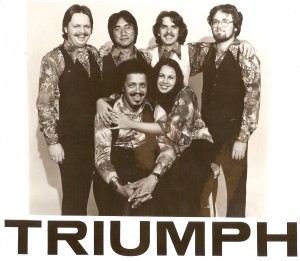
The lineup at the time of the New York recording session: (back row, left to right) bassist Ed Wright, keyboardist Richard Hundley, drummer Larr Anderson & guitarist Mike Kerrigan; (in front) Mike & Gina Antunes
(The Triumph band moved on with the same rhythm section to become Spunk & The Authentics and later Madison Avenue. They regrouped for a 25 year reunion in 2005 playing at the Red Rock in North Kingstown and The Ocean Mist in Matunuck.)
The author and the Rhode Island Music Hall of Fame would like to thank Mike Kerrigan for providing the information (data, images and the Triumph 45) which enables us to document this era of Tunes’ career in much greater detail than originally published.
Mike Antunes was the perfect choice for the the Beaver Brown band. He was a brilliant and intuitive musician, capable of playing in any style required, and his showmanship would provide an on-stage foil for John. (Like Gary, Tunes’ nickname had little to do with his musical prowess: during his time in the armed forces, his name was simply “shortened” in the time-honored tradition of military service.)
By this stage in the game, Beaver Brown had taken on professional management. Arnold Freedman and Bob Shuman, co-owners of Normandy Sound, the area’s most up-to-date, professional recording facility in Warren, Rhode Island, had offered their services as a management/production team. Kenny O’Brien was still in their corner, acting as their agent and keeping the calendar as full as ever. So John and the band decided to do it themselves.
Pride, Passion And The Thrill Of It All (1980-1982)
They began a series of recording sessions to familiarize themselves with the process, many of which took place at Normandy, culminating in an independent single release of “Wild Summer Nights” backed with “Tender Years” in 1980. Due to their ever-growing fanbase, which had now extended into New York City, down past the Jersey shore all the way to D.C. and as far west as Cleveland, the single was a smash in the Atlantic States and New England regions. It ultimately sold 10,000 copies and charted on many of the major stations in the target areas including WNEW in New York, WBCN in Boston, WMMR in Philly and WMMS in Cleveland.
This led to a showcase appearance at The Bottom Line which was broadcast nationally on FM radio. Thanks to the legion of followers they’d developed over the previous couple of years in New Haven, Connecticut (Toad’s Place) and the Jersey shore (The Fast Lane and The Stone Pony in Asbury Park), they had Manhattan surrounded! The show was a sellout and a triumph. Beaver Brown was a phenomenon not easy to ignore and the major labels came back for another look. But despite all the obvious signs, there were no takers. The band continued on for two more years, still packing them in and expanding their territory.
In 1982, fate intervened in the form of musician Kenny Vance. Kenny had been an original member of Jay & The Americans but had left the group in the early ’70s to work behind the scenes in the business. He became the musical director for Saturday Night Live which led to a successful career as a movie soundtrack producer. He scored big with John Belushi’s “Animal House” and the cult classic, “American Hot Wax.” By the early ’80s, his services were much in demand and he was offered the soundtrack to a movie based on a novel about a fictional 1960s band called “Eddie And The Cruisers.” Unhappy with the score, Kenny was debating with himself over what to do about the songs while reading through the script when he thought of Beaver Brown. The year before, he had wandered into one of their performances at The Bitter End and suddenly, instinctively knew that he had the answer. He called the movie’s director and told him, “I know of the real life Eddie And The Cruisers.” Kenny got in touch with John and told him he thought they could work on this together. The script called for a song with the title, “On The Dark Side” and as a first step, he gave John the title to try his hand. Cafferty quickly returned with his now-classic anthem of that name. They were off and running.
John was offered the score and the music would be provided by Beaver Brown with the lead actor, Michael Pare, lip-synching to John’s voice. With Kenny Vance producing, the soundtrack was recorded in fast order with the songs coming from John’s back catalog (including new versions of both “Wild Summer Nights” and “Tender Years”), some new songs written to order, and several oldies for continuity’s sake. In addition, Tunes was offered a role as Wendell Newton, the saxophonist in the fictional Cruisers and, as production progressed, the band was also given the opportunity to provide the background score and incidental music.
After their work on the soundtrack was completed, it was determined that John should relocate to Los Angeles because the soundtrack album had not yet picked up a label for distribution and that perhaps whoever wound up releasing it might also be interested in the band. For the better part of a year, he worked the LA scene while the band continued performing under the name Wild Weekend with everyone sharing the lead vocals. Wild Weekend was a success at the club level, but everyone involved knew that this was not where their futures would lie. Near end of the year, John returned to the fold with a surprise appearance during a Wild Weekend gig at Gulliver’s in North Smithfield. He jumped up on stage, led the band into a smoking version of “California Sun”, and on the next break, he revealed that the band had finally grabbed “the brass ring” – the soundtrack had been picked up by Scotti Brothers Records, one of the associated labels in the Sony/Columbia Records family and the company had offered them their own record contract.
John Cafferty & The Beaver Brown Band (1983-1986)
The film was released in 1983 to good reviews but poor business and quickly left the theaters. The soundtrack, though, had a life of its own and began selling well to the band’s fans in lieu of their long-awaited first album.
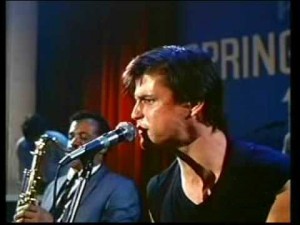
Wendell Newton & Eddie Wilson (Tunes & Michael Pare), “On The Dark Side” sequence, “Eddie And The Cruisers”
(Two songs, “On The Dark Side” and “Tender Years,” both hit the lower reaches of Billboard’s Hot 100.) The band began work on the first “official” album by the newly re-christened John Cafferty & The Beaver Brown Band with Kenny Vance producing.
Fate once again intervened in the guise of the Home Box Office. Cable TV was then in its infancy and big, hit movies were hard to license from the major studios. HBO began broadcasting “Eddie And The Cruisers” and it became a smash, propelling the soundtrack album onto the charts.
Scotti Brothers quickly re-released “On The Dark Side” and it shot into the Top 10, ultimately reaching #7 on the Hot 100.
The single traveled all the way to #1 on Billboard’s Top Rock chart and it’s accompanying video hit #1 on MTV where they both remained for five consecutive weeks. A reissue of “Tender Years” also hit the Top 40. The album quickly reached double platinum status and eventually sold over 3 million copies.
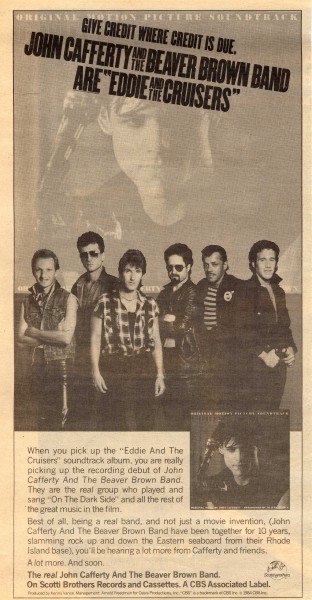
Early advertising which ran in Rolling Stone and other publications revealing the identity of the “real life” Eddie And The Cruisers
By the time the band’s new album was released, Beaver Brown was already riding the wave of success they’d only dreamed about for the last 12 years. Released in 1985, “Tough All Over” was a smash and the band began a series of tours to promote it which took them all across the country and, eventually, around the globe.
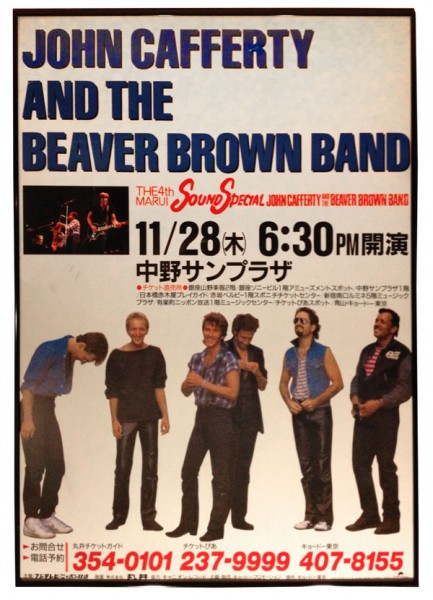 As both headliners and as opening act to such legends as The Beach Boys and Roy Orbison, John Cafferty and The Beaver Brown Band were finally able to prove to the world at large what we here in Rhode Island knew all along: that they were one of the greatest bands in the U.S.A.
As both headliners and as opening act to such legends as The Beach Boys and Roy Orbison, John Cafferty and The Beaver Brown Band were finally able to prove to the world at large what we here in Rhode Island knew all along: that they were one of the greatest bands in the U.S.A.
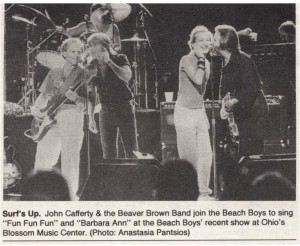
Beaver Brown meets The Beach Boys (left to right): Al Jardine, John Cafferty, Pat Lupo & Carl Wilson at a show in Cuyahuga Falls, Ohio (from Billboard Magazine, September, 1986)
The album’s title track was the first single and it climbed to #22 and again reached #1 on the Top Rock chart. The next single, “C-I-T-Y” fared even better going all the way to #18.
The band enjoyed major coverage on network and cable television appearing on Dick Clark’s “American Bandstand,” “Solid Gold” and the live MTV New Year’s offerings for both 1984 and ’85. They were also the subject of an in-depth biography for the cable series “Album Flash Documentary.”
A final single release, “Small Town Girl” stalled at #64, but the video should be of special interest to the hometown contingent of their fanbase: it was filmed here in Rhode Island at St. Lawrence School’s auditorium in the Centredale area of North Providence. It was directed by John’s cousin, Danny Smith, who has since gone on to become one of the guiding lights behind the mega-successful animated television series “Family Guy.” (It is easily found on YouTube and other video posting sites.)
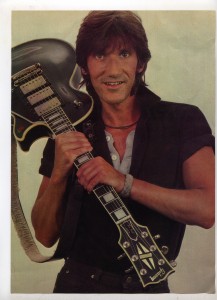
So great was the band’s success that John even achieved pinup status as evidenced by this double-sided pullout poster from a 1984 issue of 16 Magazine (The other side featured pop singer/soap opera star Jack Wagner)
Offers quickly rolled in and John scored a solo hit with “Hearts On Fire” from the soundtrack of Sylvester Stallone’s “Rocky IV” and one of the tracks from “Tough” (“The Voice Of America’s Sons”) was used as the theme to Stallone’s followup picture, “Cobra,” and also reached the Hot 100.
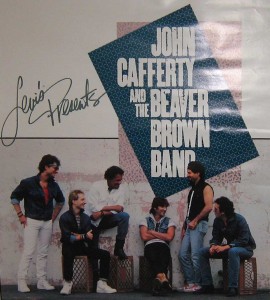
When blue jeans pioneer Levi Straus, Inc. decided to get into the Rock ‘n’ Roll business, the first band they called was Beaver Brown
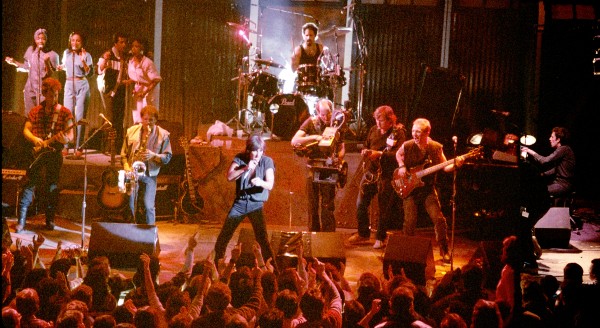
The “classic” lineup of the mighty Beaver Brown band at the peak of its powers, mid 1980s: Gary “Guitar” Gramolini, Michael “Tunes” Antunes, John Cafferty, Kenny Jo Silva, Pat Lupo & Bobby Cotoia (Photo Credit: Terry Lee Cafferty)
Runnin’ Thru The Fire (1987-1988)
Working at their own pace, assisted by longtime, trusted associates John Muldowney as assistant engineer and the band’s live sound man Karl Rasmussen as chief engineer and co-producer with John, they turned out “Roadhouse.” Artistically, it is their masterpiece, a perfect document of what Beaver Brown had been about all along. Despite a large backlog of terrific material, all new songs were written for the project and the “blue collar” themes and energetic performances perfectly captured the power of what the band was like in a live setting. There was a good-sized promotional push for the release by Scotti Bros. (full page ads in Billboard and Rolling Stone, for instance) and three singles were sent to radio and retail over the course of a year. Unfortunately, although the album sold well to their fanbase, it did not click with the general public and the band found themselves at another crossroads.
Eddie Lives…Again! (1989-1990)
In 1988, the record company was getting behind the production of a movie sequel to be called “Eddie And The Cruisers II: Eddie Lives!” and was pushing the band to provide the score. Faced with the possibility of being dropped from their contract or scoring the movie, John and the band returned to the studio with Kenny Vance and John co-producing and they duly provided the soundtrack. The bulk of the material was written as they worked through the script and plot points; the rest was drawn from the well of great, unreleased songs they’d been performing during the period between “Tough All Over” and “Roadhouse.” Tunes was again give the opportunity to reprise his role as the Cruisers’ doomed saxophonist, Wendell. The movie, released in 1989, died a quick death taking the soundtrack down with it, but the album stands the test of time: these are some of the finest songs and best recordings of their career.
Road I’m Running (1991-2001)
Jackie was a nationally renowned drummer, equally well-regarded in the R&B and jazz fields, who had built his reputation backing Tavares, one of the most successful acts of all-time with Rhode Island roots. He gave the band a different groove and provided one of the sparks which fired up the the band to pursue a new direction, because in 1992, the muse came calling again. John had new material with a somewhat new approach and it was determined that it was time to move on with things. They added a seventh member to help them achieve a truly new sound: Thom Enright.
Thom, by the early ’90s, was as legendary a character as one could find on the Rhode Island music scene. Equally adept on guitar and bass, he’d seen it all and done it all. He was one of the first musicians of his generation to enjoy a nationally released album as bass player for the Boston band, Shakey Legs; he’d recorded for Columbia Records and toured the country with Rhode Island’s own Ken Lyon & Tombstone on guitar; he’d recorded three albums for Rounder as bassist with for Duke Robillard’s first post-Roomful Of Blues project, The Pleasure Kings; and he’d been a charter member of Rhode Island legends, The Young Adults.
The Beaver Brown Band’s expanded lineup with its thicker, three-guitar army gave the new material an up-to-date sound, but also allowed John to concentrate on just singing when it was called for. Playing both lead and slide guitars, Thom interacted particularly well with Gary providing counter-melodies to Gary’s integral lines and adding previously unheard textures to not only the new songs, but to the Beaver Brown classics as well.
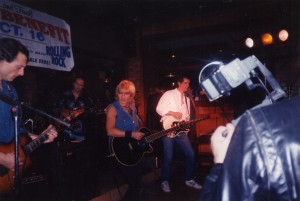
The Beaver Brown Band at the annual Big Man’s Benefit in October, 1994 (left to right): Gary Gramolini, Pat Lupo, John Cafferty & Thom Enright (Photo courtesy the Naked Truth/Steve Smith & The Nakeds Archive/Photo Credit: Ava Graham)
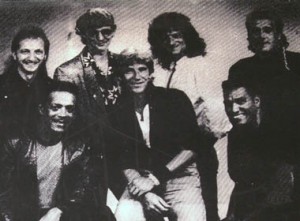
The Beaver Brown Band in the early ’90s (left to right): Pat Lupo, Mike Antunes, Thom Enright, John Cafferty, Gary Gramolini, Jackie Santos & Bobby Cotoia
Recordings from this era paint an interesting picture of the Beaver Brown Band during the early 1990s. Bobby Cotoia had recently been forced to leave his full-time position in the band for health reasons, but continued working with them when he could. The band had chosen a perfect replacement with Bobby’s blessing: Steve Burke. Steve had been a stalwart of the southern New England scene for over 20 years and was highly regarded in all genres. He was immediately able to put his own stamp on the Beaver Brown style while retaining the band’s traditions and identity.
The full unit (Gramolini and Enright, Cotoia and Burke, Cafferty, Lupo, Antunes and Santos) placed several songs in major motion pictures: “Gotta Get A Life” in the Farrelly brothers smash, “There’s Something About Mary,” as well as three songs within the soundtrack to “Jersey Girls” with Jamie Gertz and Dylan McDermott: “Ku Ku Ka Chu (Baby I Want U),” “For A Heart That’s True” and “Nobody But Me.” Unfortunately, there were no accompanying soundtrack albums for these motion pictures and one must seek out the DVD releases to hear the fruits of the labors of this transitional configuration of Beaver Brown.
In 1994, Tunes took a year-long sabbatical and the band carried on with Thom now charged with keeping things both fresh and covering for Tunes’ absence. They pulled it off admirably, but another shake-up occurred about a year after Tunes returned: Pat Lupo decided to leave the business. Thom switched to bass and the band returned to the “classic” Beaver Brown sound, but opportunity soon came knocking on Enright’s door and he left the band to take over the bass duties in Roomful Of Blues who would be open to Thom’s original songs. His replacement was the Boston-based Dean Cassell, recommended by Jackie, and he was the right man for the job in much in the same way Pino Palladino has been able to stand in John Entwistle’s spot in The Who: make your mark, but respect the past.
Where The Action Is (2002-present)
In the early 2000s, John became involved in “The Voices Of Classic Rock” and “Rock And Pop Masters”, touring revues featuring a revolving cast of lead singers from the top acts of the 1960s, ’70s and ’80s including Gary U.S. Bonds, Spencer Davis, Mike Reno (Loverboy), Jimi Jamison (Survivor), Larry Hoppen (Orleans) and many others. Similar in nature to Ringo Starr & His All-Starr Band, the participants are not only featured singing their own hits, but must commit to backing the other performers as well. The resulting mixes make for some truly interesting musical combinations and the concept has proven to be a smash with audiences around the country. The other remaining original members of Beaver Brown, Gary Gramolini and Mike Antunes, are also involved in Voices and RPM and the entire Beaver Brown band often plays host to the various ensembles when the performances are in the Northeast.
Sadly, in 2004 the band lost an original member, Bobby Cotoia. Bobby was many things besides being a great keyboard player: he will be best remembered for his wry sense of humor; for being the band’s biggest in-house energy source and cheerleader; and for being the only musician in Beaver Brown’s history to receive a co-writer’s credit with John for his contributions to “Just A Matter Of Time” from “Eddie And The Cruisers II.”
John also does work for several charitable organizations. Here in Rhode Island, he and the band are involved in Rock-N-Jock Charities founded in 2000. By cross-promoting sporting events such as golf tournaments with musical performances, Rock-N-Jock raises funds for Rhode Island children facing life altering illnesses and disabilities.
When John is off singing on his own or doing charity work elsewhere in the country, the remaining original members, Gary Gramolini and Mike Antunes have plenty to keep them busy:
Gary returned to URI in the late 1990s and earned a degree in Music Composition. He shares his knowledge with younger players as a private guitar instructor and leads his own group during Beaver Brown’s downtimes, Gary Guitar & The Grinders. He also makes regular appearances with several other acts including his latest venture, a Rhode Island all-star band called The Ocean Mystics.
Tunes remained an in-demand talent as a session man and recorded with New Kids On The Block on their “Step By Step” album along with his sons Derek and Kevin, then both members of the NKOTB band. In 1995, as a result of his involvement with fund-raising for the Smithsonian Institution’s Folk-Life Festival in Washington, D.C., he became the first member of the band to release a solo album: “Tunes From The Homeland” on Danger Records, a modern re-imagining of traditional melodies reflecting on his Cape Verdean heritage. He is also a founding member of Ernie & The Automatics, one of the most successful contemporary R&B acts in the country which features philanthropist Ernie Boch, Jr. and two members of Boston, Barry Goudreau and Sib Hashian.
John and the band have no recording plans at present, but even without future releases, their legacy is assured. As John recently put it, “A career in music isn’t something you choose – music chooses you; it becomes something that you have to do. There are no guarantees. Just because we’ve seen some success, doesn’t make us any more or any less than any other musician who’s out there doing it. It’s about how it makes you feel.” John Cafferty & The Beaver Brown Band is unquestionably one of the greatest and most successful acts in Rhode Island music history. Theirs is a story of determination and perseverance, of friendship and brotherhood and will serve as an inspiration to any young Rhode Island musician with a dream for generations to come.
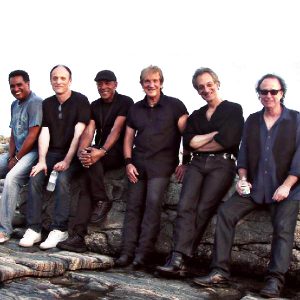
The Beaver Brown Band 2015 (left to right): Jackie Santos, Dean Cassell, Michael “Tunes” Antunes, John Cafferty, Gary “Guitar” Gramolini & Steve Burke
By Rick Bellaire
All songs written by John Cafferty unless otherwise noted
BEAVER BROWN
Wild Summer Nights b/w Tender Years (Coastline Records 45 CR-01)
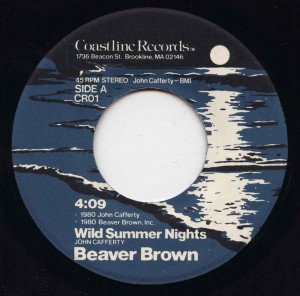 This independently released single sold over 10,000 copies in New England and the mid-Atlantic states
This independently released single sold over 10,000 copies in New England and the mid-Atlantic states
1983
BEAVER BROWN
Eddie And The Cruisers: Original Motion Picture Soundtrack
(Scotti Brothers/CBS Records LP BFZ-38929)
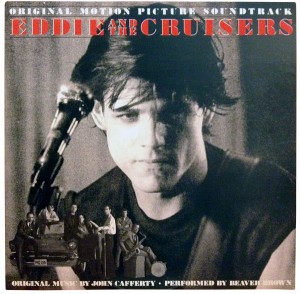 Produced by Kenny Vance
Produced by Kenny Vance
On The Dark Side
Tender Years
Runaround Sue (Dion Di Mucci, Ernest Maresca)
Down On My Knees
Hang Up My Rock And Roll Shoes (Chuck Willis)
Wild Summer Nights
Boardwalk Angel
Betty Lou’s Got A New Pair Of Shoes (Bobby Freeman)
Those Oldies But Goodies (Remind Me Of You) (Nick Curinga, Paul Politi)
Season In Hell (Fire Suite)
On The Dark Side b/w Wild Summer Nights
(Scotti Brothers/CBS Records 45 ZS4-04107)
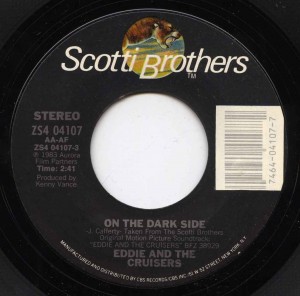 After this initial release with the artist listed as “Eddie And The Cruisers”, the record company quickly realized it was the band driving the sales, not the movie, and all subsequent releases and reissues came out under the name “John Cafferty & The Beaver Brown Band”
After this initial release with the artist listed as “Eddie And The Cruisers”, the record company quickly realized it was the band driving the sales, not the movie, and all subsequent releases and reissues came out under the name “John Cafferty & The Beaver Brown Band”
JOHN CAFFERTY & THE BEAVER BROWN BAND
Tender Years b/w Down On My Knees
(Scotti Brothers/CBS Records 45 ZS4-04327)
On The Dark Side b/w Wild Summer Nights
(Scotti Brothers/CBS Records 45 ZS4-04594)
(Scotti Brothers/CBS Records 45 ZS4-04682)
1985
Tough All Over
(Scotti Brothers/CBS Records LP FZ-39405)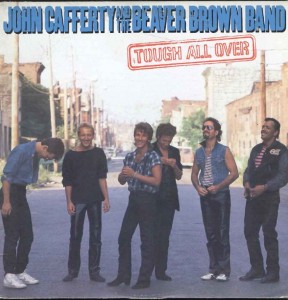
Produced by Kenny Vance
The Voice Of America’s Sons
Tough All Over
C-I-T-Y
Where The Action Is
Dixieland
Strangers In Paradise
Small Town Girl
More Than Just One Of The Boys
Tex-Mex (Crystal Blue)
(Scotti Brothers/CBS Records 45 ZS4-04891)
(Scotti Brothers/CBS Records 45 ZS4-05452)
(Scotti Brothers/CBS Records 45 ZS4-05668)
JOHN CAFFERTY
Rocky IV: Original Motion Picture Soundtrack
(Scotti Brothers/CBS Records LP SZ-40203)
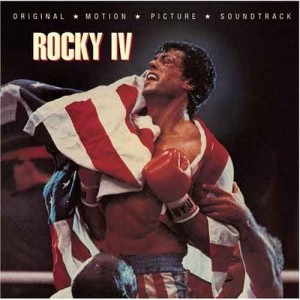 Contains one song by John Cafferty
Contains one song by John Cafferty
Produced by Vince DiCola & Ed Fruge
Hearts On Fire (Vince DiCola, Ed Fruge)
Hearts On Fire (JC solo) b/w Small Town Girl (JC & BBB)
(Scotti Brothers/CBS Records 45 ZS4-05774)
Cobra: Original Motion Picture Soundtrack
(Scotti Brothers/CBS Records LP SZ-40325)
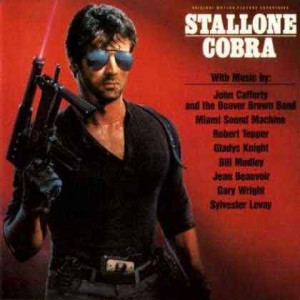 Contains one song by John Cafferty & The Beaver Brown Band
Contains one song by John Cafferty & The Beaver Brown Band
The Voice Of America’s Sons
(Scotti Brothers/CBS Records 45 ZS4-06048)
1986
The King Biscuit Flower Hour Show #634:
John Cafferty And The Beaver Brown Band
Recorded Live in Daytona Beach, Florida
(D.I.R. Broadcasting LP 06/29/1986)
Released only to radio stations to be played on-air only once as part of the series
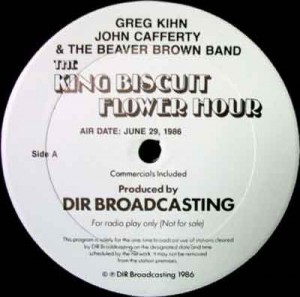 Produced by D.I.R. Broadcasting
Produced by D.I.R. Broadcasting
Voice Of America’s Sons
On The Dark Side
Small Town Girl
Tough All Over
Tender Years
C-I-T-Y
JOHN CAFFERTY & THE BEAVER BROWN BAND/MIKE CAVALIERE
All Around The World (by JC & BBB) b/w Welcome Home (by MC)
(Nard’s Records 45 NR-16880-1)
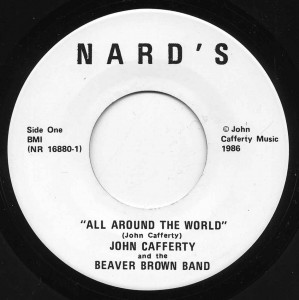 A few months after the promotional cassettes of this song were sent out, DJ Mike Nardella pressed it in a very limited run of 45s (backed with a second holiday track by another friend of his) to facilitate spinning it in the clubs. As it has never been reissued, it is probably the rarest record in their discography. The song was later covered by a popular singer on the “Beach Music” scene, Terri Gore – “The Original Beach Girl,” and it’s become a perennial holiday favorite in the Carolinas
A few months after the promotional cassettes of this song were sent out, DJ Mike Nardella pressed it in a very limited run of 45s (backed with a second holiday track by another friend of his) to facilitate spinning it in the clubs. As it has never been reissued, it is probably the rarest record in their discography. The song was later covered by a popular singer on the “Beach Music” scene, Terri Gore – “The Original Beach Girl,” and it’s become a perennial holiday favorite in the Carolinas
Roadhouse
(Scotti Brothers/CBS Records LP FZ-49879)
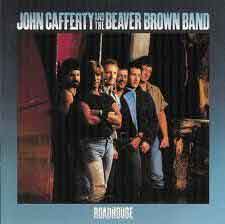 Produced by John Cafferty & Karl Rasmussen
Produced by John Cafferty & Karl Rasmussen
Co-produced by Bob Cotoia, Gary Gramolini, Kenny Jo Silva & Pat Lupo
Bound For Glory
Victory Dance
Song & Dance
Killing Time
Wheel Of Fortune
Burn The Roadhouse Down
Penetration
Wishing Well
Customary Thing
Hard Way To Go
Higher Ground
Road I’m Running
Song & Dance b/w Burn The Roadhouse Down
(Scotti Brothers/CBS Records 45 ZS4-07903)
Victory Dance b/w Road I’m Running
(Scotti Brothers/CBS Records 45 ZS4-08009)
Killing Time b/w Wheel Of Fortune
(Scotti Brothers/CBS Records 45 ZS4-08118)
Eddie And The Cruisers II: Eddie Lives!
Original Motion Picture Soundtrack
(Scotti Brothers Records SZ-45297)
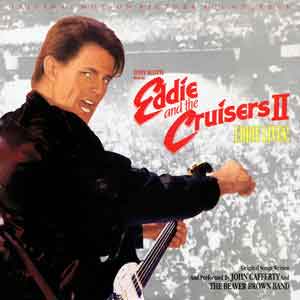 Produced by Kenny Vance & John Cafferty
Produced by Kenny Vance & John Cafferty
Runnin’ Through The Fire
Just A Matter Of Time (John Cafferty, Robert Cotoia)
Open Road
Maryia
Emotional Storm
Pride & Passion
Garden Of Eden
NYC Song
Some Like It Hot
(Keep My Love) Alive
Pride & Passion b/w Heat Of The Night (non-album B-side)
(Scotti Brothers/CBS Records 45 ZS4-68999)
Running Through The Fire b/w Emotional Storm
(Scotti Brothers/CBS Records CD5 ZSK-1858)
COMPACT DISCS & REISSUES
Beginning with the “Roadhouse” album, all product was simultaneously released on CD and “Eddie And The Cruisers” and “Tough All Over” were finally issued on CD as well. The four compact discs are well-worth seeking out in their original form as they use the original cover art and their booklets contain all of the photos, credits and lyrics found on the LP releases. All of their releases sold well enough in their original form (LPs, 45s, CDs, cassettes) that they are easily available in great condition at reasonable prices at most of the online music retailers such Amazon.com and eBay.
In 1991, after the band’s contract with Scotti Brothers had expired, the label, which still controlled the masters, switched their distribution to BMG/RCA and began milking their back catalog by issuing two albums of rarities and, in 1993, by reissuing “Tough All Over” and “Roadhouse” as Eddie And The Cruisers albums! They rationalized their actions by arguing that the fictitious band was more marketable than the real-life musicians! For serious fans, these issues should be avoided on principle and because they feature shoddy packaging and images of Michael Pare instead of JC & BBB.
There are a couple of bright spots for collectors, however, which resulted from this marketing campaign. As they exploited the catalog, they made available to the public two albums worth of John Cafferty & The Beaver Brown rarities: The first was of unreleased outtakes, mixes and B-sides from the two “Eddie” movies (including the rare “Heat Of The Night”), and the next was the first release to the public of previously unheard live recordings by the band.
In the early 2000s, Scotti Brothers sold off the rights to their catalog and it has wound up back in the hands of CBS/Sony after they merged with BMG. As a first step, as part of their popular “Extended Versions” series they have reissued the “Live In Concert” album under the band’s name complete with a photograph (taken by John’s wife Terry) of the real JC & BBB on stage. Hopefully, they will continue the work and restore the catalog to its original form as they proceed.
1991
EDDIE & THE CRUISERS
Eddie And The Cruisers: Original Motion Picture Soundtrack
(Scotti Brothers/Volcano-Legacy/BMG Records CD 32001)
Eddie And The Cruisers II – Eddie Lives:
Original Motion Picture Soundtrack
(Scotti Brothers/Volcan0-Legacy/BMG Records CD 32002)
(Scotti Brothers/BMG Records CD 75231)
Outtakes and rarities from the two “Eddie And The Cruisers” soundtracks
Produced by Kenny Vance & John Cafferty except
Tracks 2, 6 & 9 Produced by Kenny Vance
Rock ‘n’ Roll (movie dialogue)
On the Dark Side
Fool and His Money
N.Y.C. Song (instrumental with movie dialogue)
College Rap (movie dialogue)
Down on My Knees
Just a Matter of Time (instrumental with movie dialogue) (Cafferty/Cotoia)
Heat of the Night
Tender Years (movie dialogue with piano)
Tender Years
Chain Reaction
Eddie’s Confession (Movie Dialogue)
When the World Was Young
1992
Live In Concert
(Scotti Brothers/BMG Records CD 75238)
Various live recordings by John Cafferty & The Beaver Brown Band
Voice of America’s Sons
Where the Action Is
On the Dark Side
Small Town Girl
Dixieland
Tough All Over
Wild Summer Nights
Some Like It Hot
Tender Years
C.I.T.Y.
1993
Tough All Over
(Scotti Brothers/BMG Records CD 75410)
Roadhouse
(Scotti Brothers/BMG Records CD 77635)
JOHN CAFFERTY & THE BEAVER BROWN BAND
Extended Versions
(BMG Special Products CD 48864)
Reissue of the “Live In Concert” CD
OTHER APPEARANCES
JOHN CAFFERTY & BOBBY COTOIA
Face To Face: Confrontation
(Epic Records LP BFE-39999)
A fine album from this Boston band who were friends and label-mates of JC & BBB
features John on backing vocals on one song, “Shake The World” and Bobby on keyboards on another, “The 4th Watch”
JOHN CAFFERTY & MARK CUTLER
Rhode Island Bandwagon: Three Sides Of Hunger
(Calder Records 12″ EP CR-6001)
Charity release containing one song featuring JC, “Where Home Is”
(Music by Mark Cutler, Lyrics by Al Gomes, Mark Cutler & John Cafferty)
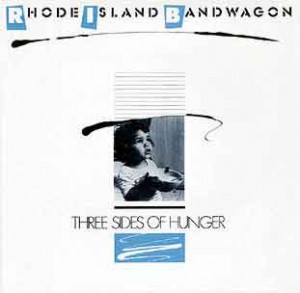 2000
2000JOHN CAFFERTY, GARY GUITAR & BOBBY COTOIA
The Time Is Now: The 1 of 52 Artist Hunger Network
(End Hunger/Soft Wind Records CD 152-001)
Charity release containing one song, “Wheel Of Fortune (Live/Acoustic)”
JOHN CAFFERTY & THE BEAVER BROWN BAND
Light Of Day: A Tribute To Bruce Springsteen
(Schoolhouse Records CD SHR-0022)
Charity release for Michael J. Fox’s Light Of Day Parkinson’s Disease Foundation
containing one song by JC & BBB, “The E Street Shuffle”
GARY “GUITAR” GRAMOLINI
Perspectives 2
(Queen City Records LP 103125)
Second in a series of University Of Rhode Island student yearbook recordings, these annual psych-folk LP offerings have become highly collectible around the world (fetching$50-$200 each) This edition features Gary playing mandolin on one song, “Joint Effort”
1961
MICHAEL “TUNES” ANTUNES
The Blazers: Grasshopper b/w A Little Bit Of Slop
(Mundo Records 45 864)
1963
The Blazers with Li’l Ray Armstrong: Boom-Boom b/w A-Time
(Empire Records 45 2001/2002)
1976
Mike & Gina and Triumph: Only You (mono) b/w same (stereo)
(Steppe Records 77 x 49)
Promotional record recorded with Tunes’ popular southern New England club band Triumph
1990
New Kids On The Block: Step Be Step
(Columbia Records CD CK-45129)
Tunes contributes (uncredited) saxophone to “Baby, I Believe In You”
Michael Antunes: Tunes From The Cape Verdean Homeland
(Danger Records CD DRR-3222)
Ernie & The Automatics: Low Expectations
(Open E Records CD OE-61)
2008
ROCK & POP MASTERS
One Night In Weston
(CreateSpace Records CD)
Live soundtrack album to the film features John & Tunes on three tracks:
On The Dark Side
Tough All Over
C-I-T-Y
2001
VOICES OF CLASSIC ROCK
The Voices have a song featuring John available from most download services such as iTunes and Amazon.com:
The Battle Hymn Of The Republic
from the download EP: Voices For America
A studio recording featuring all the members trading lines released for the benefit of the families of the victims after the September 11 attacks
FEATURE FILM APPEARANCES
All of these movies are available on DVD from most online retailers such as Amazon.com
and as downloads from such services as NetFlix and iTunes
Eddie And The Cruisers
Score by John Cafferty, Performed by Beaver Brown
Features Tunes as the Cruisers’ sax player, Wendell Newton
Eddie And The Cruisers II: Eddie Lives!
Score by John Cafferty, Performed by John Cafferty & The Beaver Brown Band
Features Tunes reprising his role as the Cruisers’ sax player, Wendell
Jersey Girl
features three songs within the movie’s soundtrack by JC & BBB
Ku Ku Ka Chu (Baby I Want U)
For A Heart That’s True
Nobody But Me
There’s Something About Mary
features one song within the movie’s soundtrack by JC & BBB
Gotta Get A Life
Rock & Pop Masters: One Night In Weston – A Live Concert Film
features John and Tunes on three tracks
On The Dark Side
Tough All Over
C-I-T-Y
